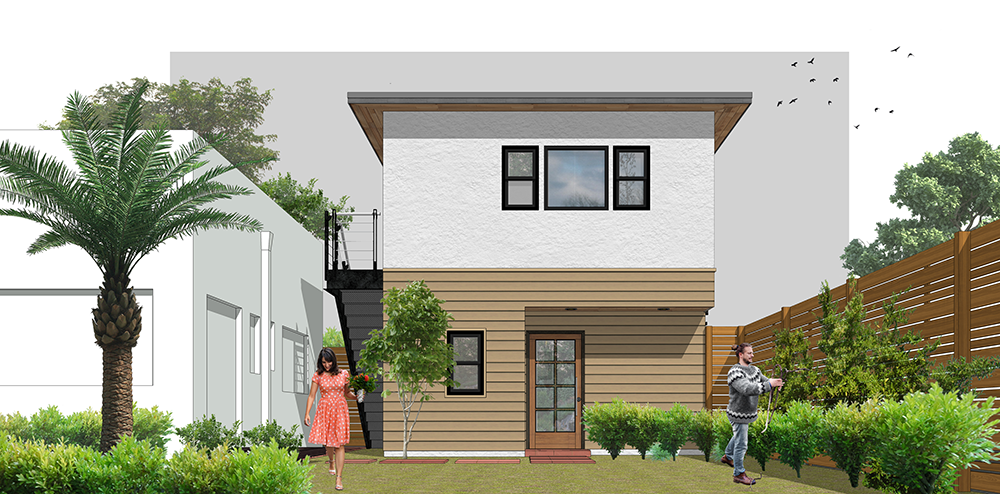What is an ADU?
ADU stands for Accessory Dwelling Unit. In an effort to increase affordable housing, the state of California passed a series of bills in 2017 that allowed ADUs in all single-family zones throughout the state. Today, ADUs are also allowed in multifamily zones.
ADUs are also referred to as granny flats, casitas, or companion units. There are three main types of ADUs including:
- Detached
- Attached
- Garage conversions
Top Reasons to build an ADU in California
There are many reasons why ADUs have become extremely popular among California homeowners. In fact, the City of San Diego has seen an increase of 317% of ADU applications from 2019 to 2020. And, by all accounts, the number keeps growing as more and more homeowners are catching onto the benefits of ADUs.
Here are the three most popular ADU benefits:
1) Rental Income
With the high cost of home ownership in California, many homeowners are turning to ADUs to create rentable units to help offset their mortgage costs.
2) Aging-in-Place
Did you know that nursing homes can cost about $6,000 a month on average? This is why aging-in-place is one of the most popular reasons homeowners are building ADUs. It’s a great way to save on nursing home costs while keeping elderly parents and family members safe and close to home.
3) Increased Property Value
Through the addition of square footage and creating an additional dwelling on your property, you can increase the value of your property.
2017 California ADU Laws
The first set of ADU laws were passed by the state of California in 2017 with Senate Bill 1069 – which included a set of code updates relating to land use and zoning. This bill introduced the term “accessory dwelling unit.” The goal of this bill was to address the housing crisis in California by increasing the number of affordable housing units throughout the state.
The bill clarified the rules and requirements for ADUs and instructed that every municipality throughout the state must move to allow them in single-family zones. Although certain municipalities such as San Diego quickly adopted and embraced the new ADU laws, not all cities were as welcoming.
Certain municipalities that did not like the idea of ADUs, created stringent requirements that made it nearly impossible for many homeowners to build ADUs on their properties. This prompted the state of California to pass a new set of laws in 2020 to make building ADUs much easier.
New California ADU Laws in 2020
Senate Bill 13 introduced a series of new ADU laws that went into effect at the start of 2020. The goal for this bill was to ease requirements for ADUs, making it easier than ever before to add an accessory dwelling unit to both single-family and multifamily zoned properties. The bill also includes a set of requirements that all municipalities must abide by.
Here’s a summary of the new 2020 California ADU laws:
- Removed minimum lot size requirements
- Minimum 800 sq ft ADU must be allowed
- Removed parking requirements for garage conversions
- Allows ADUs on multifamily properties
- Allows one ADU and one Junior ADU on a single-family zoned property
- Removes the owner-occupancy requirement for ADUs
- Establishes a maximum 60-day application review time
These law updates were created to help ease ADU restrictions in local municipalities and increase feasibility for many property owners. If you’re unsure about the feasibility of an ADU on your property, contact us today for a free evaluation.
Know the ADU Regulations for your Municipality
When evaluating the feasibility of your ADU project, it’s important to take a close look at the local rules and requirements as stated by your local municipality. Although the laws outlined relax many restrictions, every municipality treats ADUs differently and each has its own ADU ordinance that property owners must abide by.
On the other hand, many municipalities have local ordinances that go above and beyond the state-level ADU requirements. For example, the City of San Diego has waived all Development Impact Fees, even those over 750 sq ft. Staying in tune with your local municipality’s law updates is key to understanding what you can and can not build on your property.
At Ruland Design Group, we’ve worked with many local municipalities throughout the San Diego area to help our clients realize the maximum potential for their properties through the addition of ADUs.
If you have an ADU project in mind, contact us today to learn more about what’s possible for your property.


